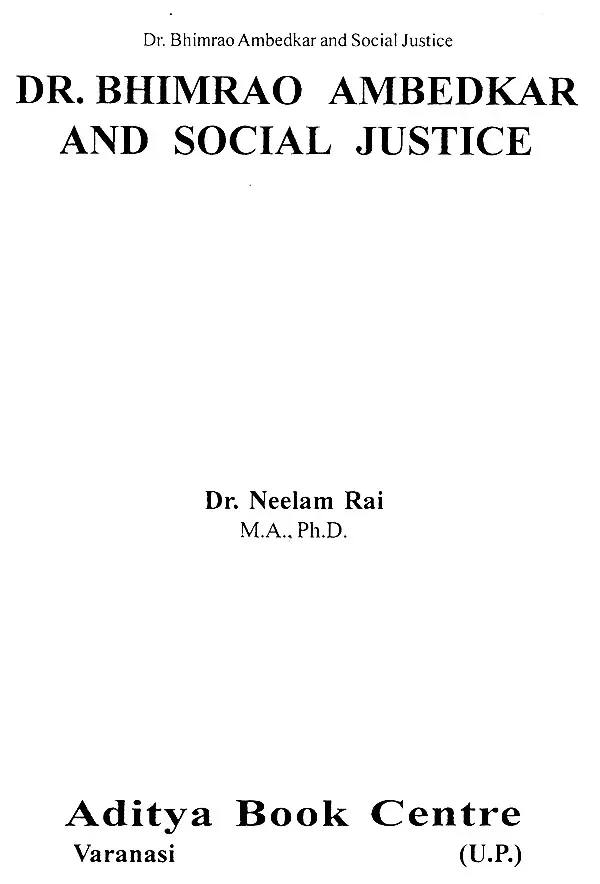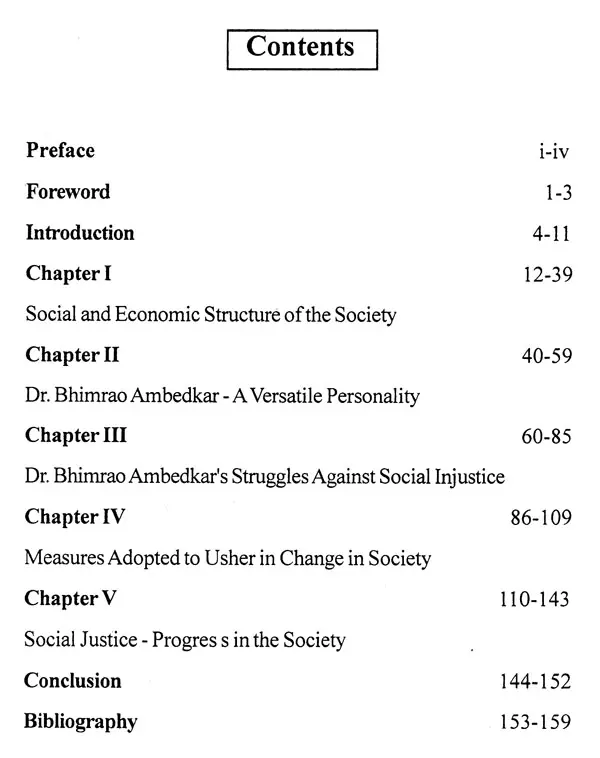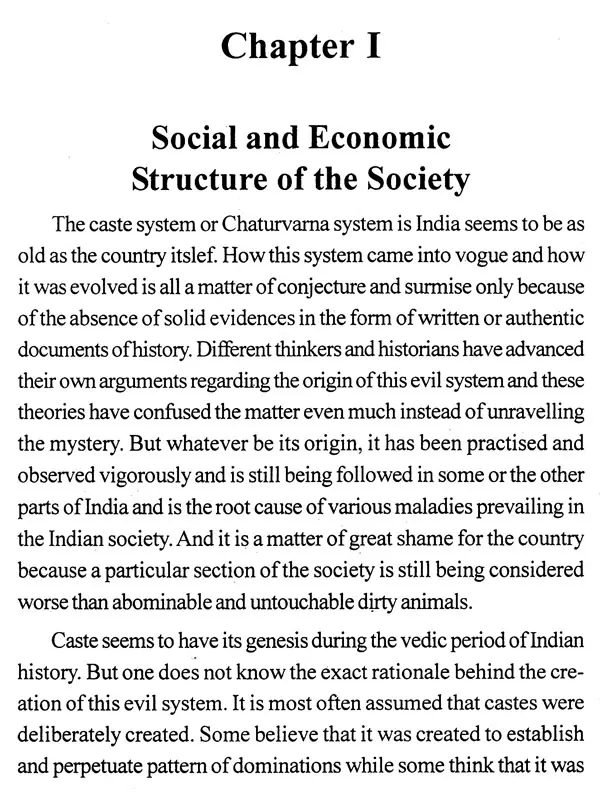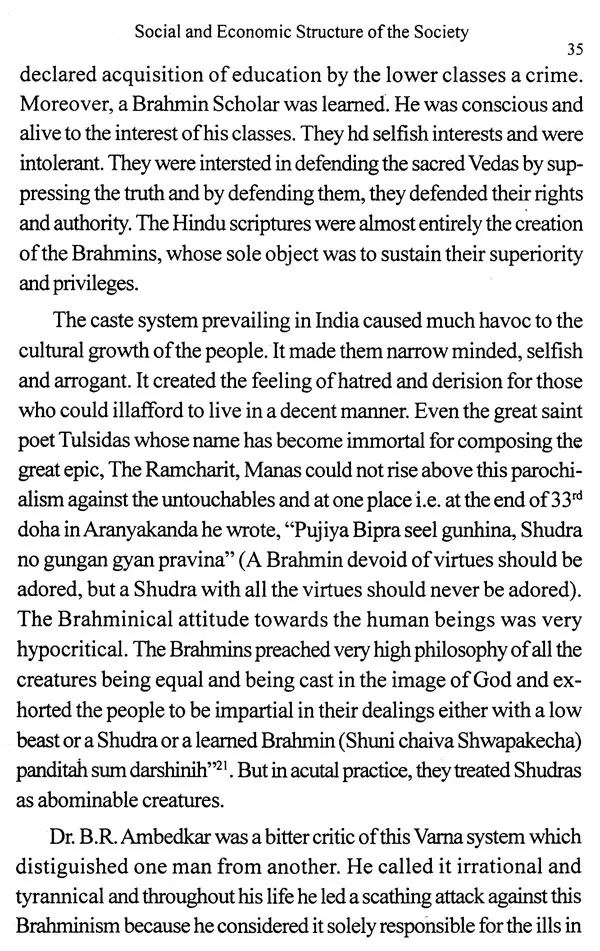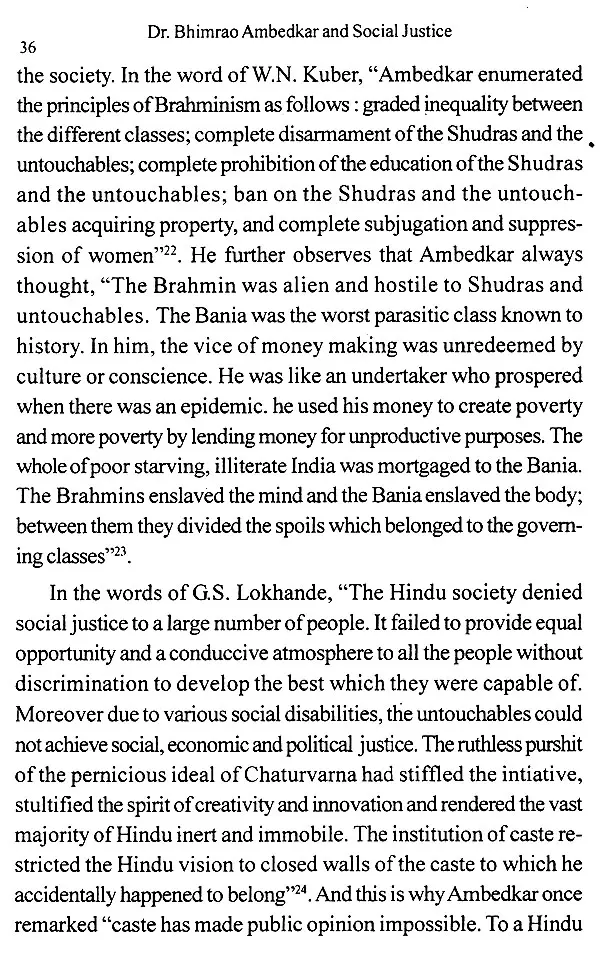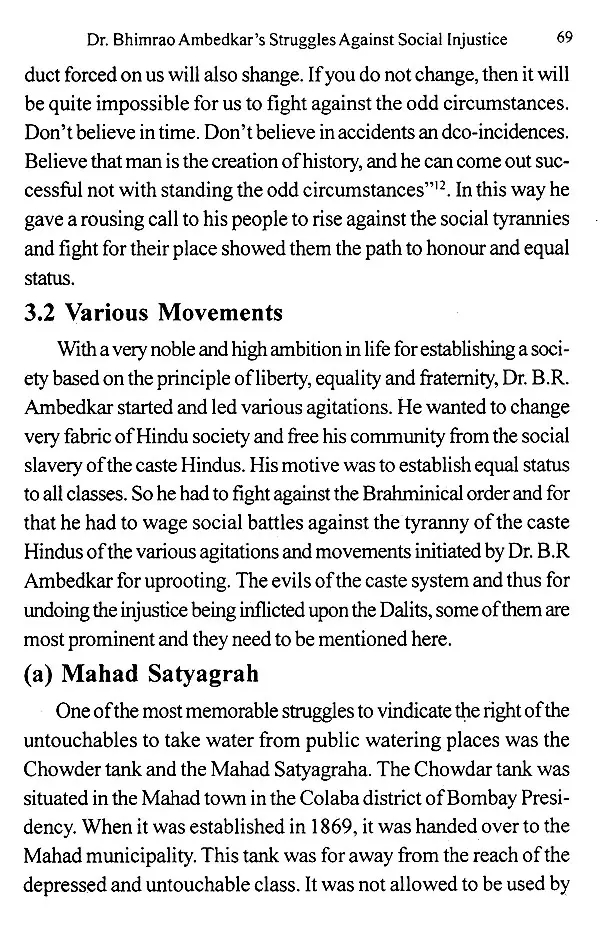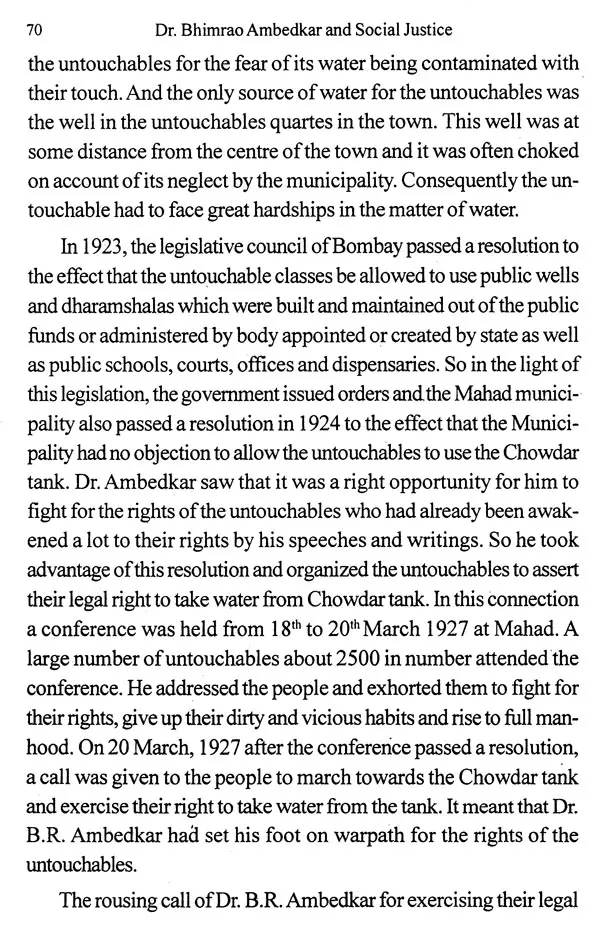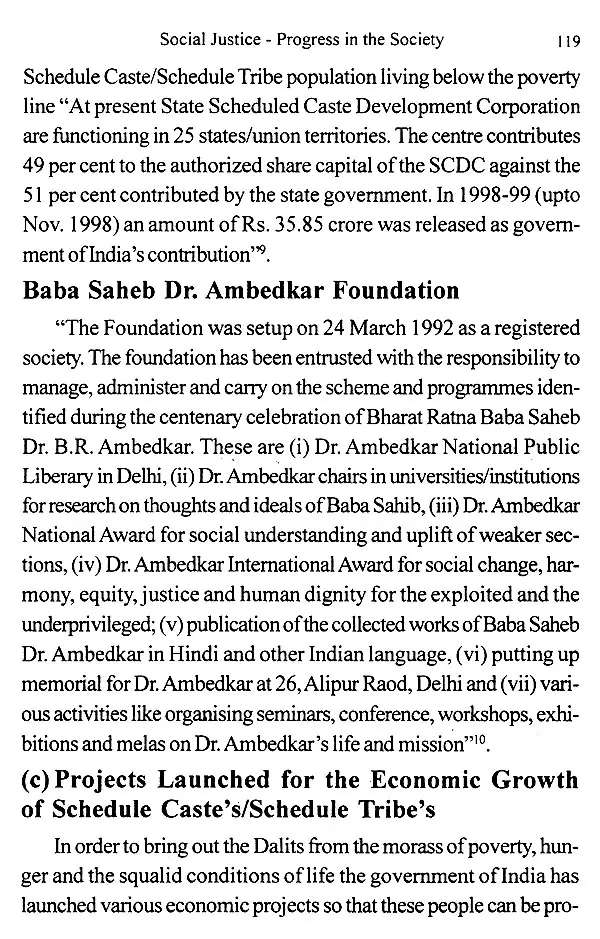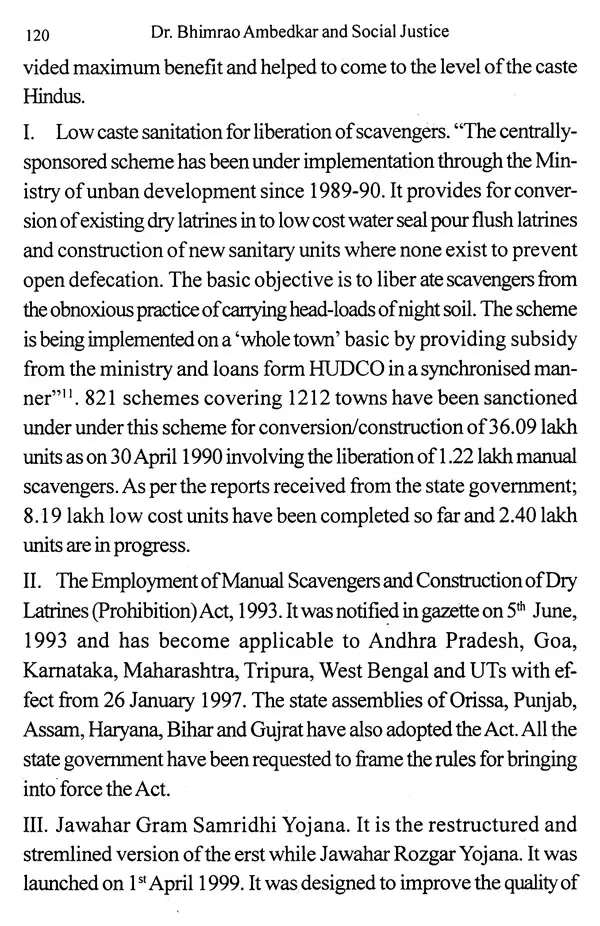
Dr. Bhimrao Ambedkar And Social Justice
Book Specification
| Item Code: | UAQ935 |
| Author: | Neelam Rai |
| Publisher: | Aditya BOOK Centre, Varanasi |
| Language: | English |
| Edition: | 2008 |
| ISBN: | 9788190585545 |
| Pages: | 159 |
| Cover: | HARDCOVER |
| Other Details | 9.00 X 6.00 inch |
| Weight | 320 gm |
Book Description
The present book "Dr. Bhimrao Ambedkar & Social Justice" is in fact the published version of the research work by the author and on which the Ph.D degree has been awarded by the department of history of the Banaras Hindu University. As the book highlights the struggles of Dr.. B.R. Ambedakar for creating honourable place for the dalit in the Indian society and as it points. out how tremendous change has taken place in the out look of the caste Hindus towords the downtrodden and how they are emerging out of the quagmire of poverty and untouchbility.
The reader will certainly find the book very interesting and informative. It will help them to get full knowledge about the struggle, of the dalit to cast off the pall of untouchability and to make them. in the Indian society. The book then achieves a great significance in the sense that it throws a great light on the revolutionary nature of Dr. B.R. Ambedkar whose achievements in his life time were nothing short of miracle. In short the book will prove to be an Interesting study of struggles and achievements of Dr. B.R, Ambedkar.
Dr. Mrs. Neelam Rai was born in Dec. 1973 in rohtak (Haryana) she had her basic and Higher Education up to post graudation level from the prestigious institutions of rohtak and after her marriage she shifted to varanasi.
She was awarded P.hd degree on the topic of "Dr. Bhimrao and Social Justice" by the department of history B.H.U. Varanasi. She has flavour for learning and teaching. She has been contributing to the various illustrious magazines and many articles have been published and many are in the process of getting printed. At present she each engaged in teaching work and providing benefit of her knowledge and learning to the student.
Dr. B. R. Ambedkar, whose figure appears to be embossed on almost all the pages of the Indian Constitution as its architect and who has influenced millions of people of different sections of Indian Society in varying degrees and whose name has become immortal among the galaxy of the great personages of history, is certainly an intellectual study. He had an unquenchable thirst for knowledge and his passion for book was very unique and consequently he acquired vast knwoledge in different fields of learning. He was a voracious reader. He knew seven languages. He distinguished himself in history, economics, politics, law and constitution. So to study him and to understand him fully requires vast knowledge and wide experience. And to circumscribe his achievements as a great revolutionary and social reformer who remained engaged all his life in shattering the old images of society like an iconoclast is to belittle his importance.
Although to have a complete and through knowledge of the ideologies of such a versatile genius like Bhimrao Ambedkar who brought a sea change in the life of the downtrodden and also in the outlook of the exploiters class towards these unprivileged people who had lived a life of mortification and virtual slavery of both the British rule and the Brahminical order of the society is very difficult, yet an effort has been made in this book to present the various as pects concerning his life, struggle and innovatives for the uplift of the Dalits in Indian society so that a proper estimation can be made of Ambedkar's contributions and his personality. And to be acquainted with all the transformations or social changes ushered in by this great luminary of law and Messiah of the untouchables, it is imperative to highlight the social, economic and religious conditions existing in In dia prior to the emergence of this great personality of history and emancipator of the Dalits. So that first chapter of my book deals with the socio-economic structure of the contemporary Indian soci ety as it existed before B.R. Ambedkar was born.
The early influences which shaped and moulded Ambedkars's life mark the core of any study of such a great crusader fo his time. to skip these formative influences and jump directly to his new vi sions which came to be regarded as gospel, truths for the untouch able class andh which stirred-the human psyche all over the country and which drew the attention of the people of the world to wards the miserable and pitiable conditions of life of the untouchables, will be just like leaving a great hiatus unbridged. And then it will be very difficult to explain and understand his philosophies in full. So the sec ond chapter of my book is going to deal, though very briefly, with all those influences that sharpened B.R. Ambedkar's wit and turned him into a bitter and hositile critic of Manuvadi system of the Caste Hindus.
Dr. B.R. Ambedkar-the man of Praxis, a great thinker and social reformer devoted his whole life for the removal of the evils of caste system especially in the eradication of untouchability and social awareness amongst the downtrodden, depressed Dalits-the untouchables. Ambedkar provided a milieue and platform for their social justice.
The book entitled "Dr. Bhim Rao Ambedkar and Social Justice" is a primary data based sincere hard work and an interest ing study in the struggles and efforts made by Dr. Ambedkar for uplifting the social status of so called "Pancham-Varna" of Hindu so cial system. It presents a very clear picture of murky situation pre vailing in Indian Social System at the time of Ambedkar's emergence. The history reveals the stigma of caste system pushing millions of untouchables bound to hire in degraded, dehumanised lives performing the most defiling dirty impure and menial tasks. Consequently the author has highlighted the various transformations which emerged in the perspective of the Caste Hindus towards the downtrodden because of the steps taken by the government for ameliorating the abject conditions of the so called Dalits. Really Dr. Ambedkar will always be in the memory of Indians for ceating an awakening among them to their rights of equality, liberty and fratemity and thus bringing a great ideological changes in the country.
The book is thus a pioneer work in the study of Dr. Bhim Rao Ambedkar and we hope it will inspire the readers to go for further deep study of Ambedkar's contribution to the upliftment of downtrodden and their honourable establishment in the society. We congratulate the author for this commendable primary data based work in the market for the study of further researchers and great academicians.
The history of India is a tally of events of caste-discrimination preached and practiced in the name of God. The caste as the institu tion is the survival of pre jural society and the early juris-prudence of India, was sustained by the belief in supernatural agencies assuaged by the magic charms and rituals. It is due to the role of religion in early laws that the priest became the most potent instrument of sta bility and status. In Europe the priest and the supremacy of the Church was challenged by intellectuals but in India the challenge to the priestly class and the tradition came much later when the British rule for the first time introduced masses to the democratic values which find expression in the proclimation of 1858 which states: "And it is our further will that, so far as may be, our subjects of whatever race or creed, be freely and impartially admitted to offices in our services the duties of which they may be qualified by their education, ability and integrity to discharge". In a society of institutionalised gradation and hierarchy, this was a revolution in ideals of equlity which Dr. B.R. Ambedkar has advocated in a spirit of social democracy and justice.
Dr. B.R. Ambedkar, a pioneer of social justice, observes that "the population of India is mixture of Aryans, Dravidians, Mongo lians and Scythians. Ethnically all people are heterogeneous. Accord ing to him, it is the unity of culture that binds the people of Indian Penisula from one end to the other. After evaluating the theories of various authorities on case, Dr. Ambedkar observes that "the super imposition of endogamy over exogamy is the main cause of forma tion of caste groups. To him, sub-division of a society is a natural phenomenon and there groups become castes through ex-commu nication and imitation.
The term 'caste' is a comprehensive system of life dealing with food, marriage education association and worship. In the words of WN. Kuber, "caste is defined as hereditary endogamous, usually localized group, having traditional association with an occupation. and a particular position in the local hierachy of castes". While Tho mas Mathew states "caste is not merely a division of labour, it is also a division of labourers. It is hierarchy in which divisions of labourers are graded or one above the other", K.M. Pannikar, another re nowned personality and authority of history says that "caste is a so cial imperialism perfected by experience and maintained by religious sanction". Even GS. Ghurya holds that "endogamy as the essence of the caste system". All these definitions lead to certain basic fea tures of the caste and there features have been summarized by W. N. Kuber as under.
Book's Contents and Sample Pages
